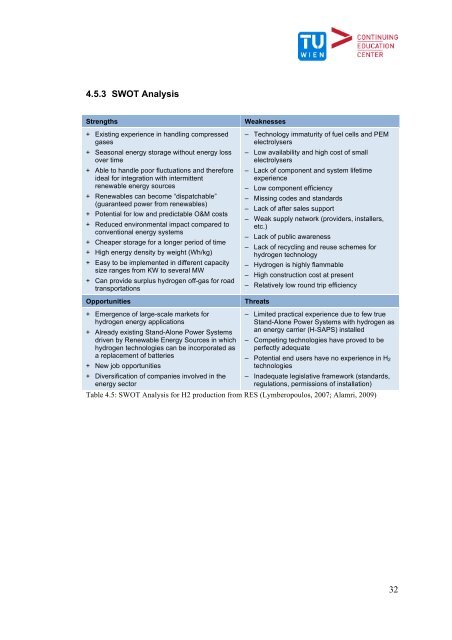The relevance of energy storages for an autarky of electricity supply ...
The relevance of energy storages for an autarky of electricity supply ...
The relevance of energy storages for an autarky of electricity supply ...
You also want an ePaper? Increase the reach of your titles
YUMPU automatically turns print PDFs into web optimized ePapers that Google loves.
4.5.3 SWOT Analysis<br />
Strengths Weaknesses<br />
+ Existing experience in h<strong>an</strong>dling compressed<br />
gases<br />
+ Seasonal <strong>energy</strong> storage without <strong>energy</strong> loss<br />
over time<br />
+ Able to h<strong>an</strong>dle poor fluctuations <strong>an</strong>d there<strong>for</strong>e<br />
ideal <strong>for</strong> integration with intermittent<br />
renewable <strong>energy</strong> sources<br />
+ Renewables c<strong>an</strong> become “dispatchable”<br />
(guar<strong>an</strong>teed power from renewables)<br />
+ Potential <strong>for</strong> low <strong>an</strong>d predictable O&M costs<br />
+ Reduced environmental impact compared to<br />
conventional <strong>energy</strong> systems<br />
+ Cheaper storage <strong>for</strong> a longer period <strong>of</strong> time<br />
+ High <strong>energy</strong> density by weight (Wh/kg)<br />
+ Easy to be implemented in different capacity<br />
size r<strong>an</strong>ges from KW to several MW<br />
+ C<strong>an</strong> provide surplus hydrogen <strong>of</strong>f-gas <strong>for</strong> road<br />
tr<strong>an</strong>sportations<br />
Opportunities Threats<br />
+ Emergence <strong>of</strong> large-scale markets <strong>for</strong><br />
hydrogen <strong>energy</strong> applications<br />
+ Already existing St<strong>an</strong>d-Alone Power Systems<br />
driven by Renewable Energy Sources in which<br />
hydrogen technologies c<strong>an</strong> be incorporated as<br />
a replacement <strong>of</strong> batteries<br />
+ New job opportunities<br />
+ Diversification <strong>of</strong> comp<strong>an</strong>ies involved in the<br />
<strong>energy</strong> sector<br />
– Technology immaturity <strong>of</strong> fuel cells <strong>an</strong>d PEM<br />
electrolysers<br />
– Low availability <strong>an</strong>d high cost <strong>of</strong> small<br />
electrolysers<br />
– Lack <strong>of</strong> component <strong>an</strong>d system lifetime<br />
experience<br />
– Low component efficiency<br />
– Missing codes <strong>an</strong>d st<strong>an</strong>dards<br />
– Lack <strong>of</strong> after sales support<br />
– Weak <strong>supply</strong> network (providers, installers,<br />
etc.)<br />
– Lack <strong>of</strong> public awareness<br />
– Lack <strong>of</strong> recycling <strong>an</strong>d reuse schemes <strong>for</strong><br />
hydrogen technology<br />
– Hydrogen is highly flammable<br />
– High construction cost at present<br />
– Relatively low round trip efficiency<br />
– Limited practical experience due to few true<br />
St<strong>an</strong>d-Alone Power Systems with hydrogen as<br />
<strong>an</strong> <strong>energy</strong> carrier (H-SAPS) installed<br />
– Competing technologies have proved to be<br />
perfectly adequate<br />
– Potential end users have no experience in H2<br />
technologies<br />
– Inadequate legislative framework (st<strong>an</strong>dards,<br />
regulations, permissions <strong>of</strong> installation)<br />
Table 4.5: SWOT Analysis <strong>for</strong> H2 production from RES (Lymberopoulos, 2007; Alamri, 2009)<br />
32
















